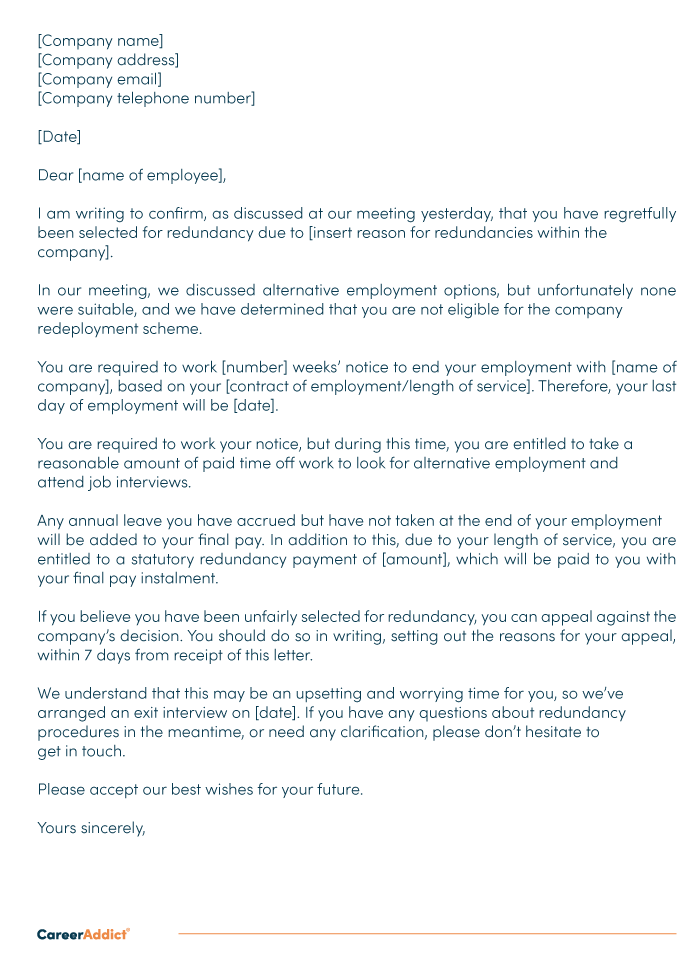Who Pays Redundancy Money? Recognizing Employer Obligations in the UK
Who Pays Redundancy Money? Recognizing Employer Obligations in the UK
Blog Article
Checking Out the Operational Characteristics of Firm Redundancy and Its Long-Term Sustainability

Redundancy Approaches for Service Continuity
In order to guarantee undisturbed operations, services must carry out efficient redundancy approaches for service connection. Redundancy in this context refers to the replication of important components or functions within a system to minimize the influence of potential failings. By including redundancy strategies, organizations can improve their strength against disturbances created by different elements such as all-natural disasters, devices failures, or cyber-attacks.
One usual redundancy technique is the application of backup systems and data storage space services. This includes producing duplicates of essential information and systems that can be activated in case of a primary system failure. Additionally, companies can develop repetitive interaction networks and source of power to maintain connectivity and operations during unexpected events.
In addition, cross-training staff members to execute numerous duties within the company can act as a beneficial redundancy method. This makes certain that crucial tasks can still be performed also if vital employees are unavailable due to illness or various other factors. Overall, efficient redundancy approaches are vital for services to support operational continuity and reduce the impact of possible interruptions.
Impact of Redundancy on Business Strength
Given the important role redundancy approaches play in making certain business continuity, checking out the effect of redundancy on organizational strength becomes imperative for comprehending the alternative functional characteristics of a company. Redundancy, when strategically executed, can considerably add to enhancing an organization's resilience in the face of unforeseen obstacles.
In addition, redundancy can foster technology and imagination within an organization as employees feel encouraged to take computed dangers, understanding that there is a safety net to support them in instance of failure. Generally, the effect of redundancy on organizational strength is profound, forming the long-lasting sustainability and success of a company.
Stabilizing Efficiency and Adaptability in Redundancy
Achieving an unified balance between functional effectiveness and adaptive adaptability is an essential challenge in the critical implementation of redundancy within organizations. Reliable operations are important for keeping efficiency and cost-effectiveness, making certain that resources are made use of optimally. Nevertheless, extreme emphasis on effectiveness alone can bring about rigidness, making it hard for organizations to adjust to unexpected changes or challenges. On the other hand, adaptability allows companies to respond nimbly to developing circumstances, cultivating innovation and resilience. Yet, way too much versatility without a strong functional foundation can result in inadequacies and inconsistency.
To balance efficiency and versatility in redundancy preparation, companies have to thoroughly examine their functional demands, market characteristics, and strategic objectives. Applying lean practices can enhance efficiency by eliminating and improving processes waste, while fostering a society of adaptability and continuous improvement can boost adaptability. Furthermore, purchasing cross-training programs and durable communication channels can aid grow a flexible workforce with the ability of handling varied jobs throughout periods of transition. Ultimately, locating the best stability between efficiency and flexibility is essential for developing a resilient and lasting company despite unpredictability.
Long-Term Sustainability With Redundancy Preparation
To guarantee long-lasting practicality and security, companies must purposefully align their redundancy preparation link with long-term sustainability objectives, therefore harmonizing functional efficiency with adaptive flexibility. Lasting sustainability through redundancy preparation involves more than simply temporary cost-cutting procedures. It needs an extensive critical technique that anticipates future difficulties and possibilities. Companies ought to view redundancy not as a responsive solution to immediate issues yet as a positive strategy for long-term success. By incorporating redundancy preparation with sustainability objectives, companies can produce a resistant framework that can withstand various market fluctuations and internal changes.

Proactive Actions for Lasting Company Procedures
Just how can business proactively boost their functional sustainability for lasting success? Applying positive actions is crucial for firms intending to ensure lasting operations.
Furthermore, fostering a culture of continuous renovation and knowing within the organization can boost adaptability to altering market conditions and customer needs. Urging employee involvement in decision-making processes and supplying chances for expert development can increase spirits, efficiency, and total efficiency. Developing clear objectives, checking vital efficiency indications, and on a regular basis reviewing progression are essential parts of proactive sustainability management.
Collaborating with providers, consumers, and various other stakeholders to promote lasting techniques throughout the supply chain can develop a surge effect of positive impact - redundancy pay if company goes bust. By taking proactive steps in the direction of functional sustainability, firms can construct resilience, drive technology, and safeguard their long-lasting success in an ever-evolving organization landscape
Conclusion

In the world of business management, the strategic implementation of firm redundancy stands as a click here to find out more critical yet elaborate method that requires a fragile balance in between functional efficiency and long-lasting feasibility. By exploring the functional dynamics that underpin company redundancy and assessing its more comprehensive implications for business strength and flexibility, a nuanced understanding of exactly how redundancy techniques can shape the future trajectory of a firm starts to unfold.Offered the crucial duty redundancy methods play in making sure organization connection, checking out the influence of redundancy on business durability ends up being crucial for recognizing the alternative functional characteristics of a firm. Generally, the effect of redundancy on organizational why not find out more durability is extensive, forming the long-term sustainability and success of a company.
In final thought, understanding the functional dynamics of firm redundancy is crucial for making sure long-lasting sustainability.
Report this page